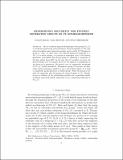Files in this item
Determining solubility for finitely generated groups of PL homeomorphisms
Item metadata
| dc.contributor.author | Bleak, Collin | |
| dc.contributor.author | Brough, Tara | |
| dc.contributor.author | Hermiller, Susan | |
| dc.date.accessioned | 2021-03-18T15:30:02Z | |
| dc.date.available | 2021-03-18T15:30:02Z | |
| dc.date.issued | 2021-07-19 | |
| dc.identifier | 231627147 | |
| dc.identifier | fee8e372-4395-4547-a135-9df0875c0f52 | |
| dc.identifier | 85115354865 | |
| dc.identifier | 000699713900002 | |
| dc.identifier.citation | Bleak , C , Brough , T & Hermiller , S 2021 , ' Determining solubility for finitely generated groups of PL homeomorphisms ' , Transactions of the American Mathematical Society , vol. 374 , no. 10 , pp. 6815-6837 . https://doi.org/10.1090/tran/8421 | en |
| dc.identifier.issn | 0002-9947 | |
| dc.identifier.other | ArXiv: http://arxiv.org/abs/1507.06908v1 | |
| dc.identifier.other | ORCID: /0000-0001-5790-1940/work/98487801 | |
| dc.identifier.uri | https://hdl.handle.net/10023/21656 | |
| dc.description | Funding: The first and second authors were partially supported by EPSRC grant EP/H011978/1. The third author was partially supported by grants from the Simons Foundation (#245625) and the National Science Foundation (DMS-1313559) | en |
| dc.description.abstract | The set of finitely generated subgroups of the group PL+(I) of orientation-preserving piecewise-linear homeomorphisms of the unitinterval includes many important groups, most notably R. Thompson’s group F. Here, we show that every finitely generated subgroup G < PL+(I) is either soluble, or contains an embedded copy of the finitely generated, non-soluble Brin-Navas group B, affirming a conjecture of the first author from 2009. In the case that G is soluble, we show the derived length of G is bounded above by the number of breakpoints of any finite set of generators. We specify a set of ‘computable’ subgroups of PL+(I) (which includes R. Thompson’s group F) and give an algorithm which determines whether or not a given finite subset X of such a computable group generates a soluble group. When the group is soluble, the algorithm also determines the derived length of ⟨X⟩. Finally,we give a solution of the membership problem for a particular familyof finitely generated soluble subgroups of any computable subgroup of PL+(I). | |
| dc.format.extent | 23 | |
| dc.format.extent | 266770 | |
| dc.language.iso | eng | |
| dc.relation.ispartof | Transactions of the American Mathematical Society | en |
| dc.subject | Piecewise linear homeomorphism | en |
| dc.subject | Thompson's group | en |
| dc.subject | Soluble | en |
| dc.subject | Membership problem | en |
| dc.subject | QA Mathematics | en |
| dc.subject | T-NDAS | en |
| dc.subject.lcc | QA | en |
| dc.title | Determining solubility for finitely generated groups of PL homeomorphisms | en |
| dc.type | Journal article | en |
| dc.contributor.sponsor | EPSRC | en |
| dc.contributor.institution | University of St Andrews. School of Mathematics and Statistics | en |
| dc.contributor.institution | University of St Andrews. Pure Mathematics | en |
| dc.contributor.institution | University of St Andrews. Centre for Interdisciplinary Research in Computational Algebra | en |
| dc.identifier.doi | 10.1090/tran/8421 | |
| dc.description.status | Peer reviewed | en |
| dc.identifier.grantnumber | EP/H011978/1 | en |
This item appears in the following Collection(s)
Items in the St Andrews Research Repository are protected by copyright, with all rights reserved, unless otherwise indicated.

